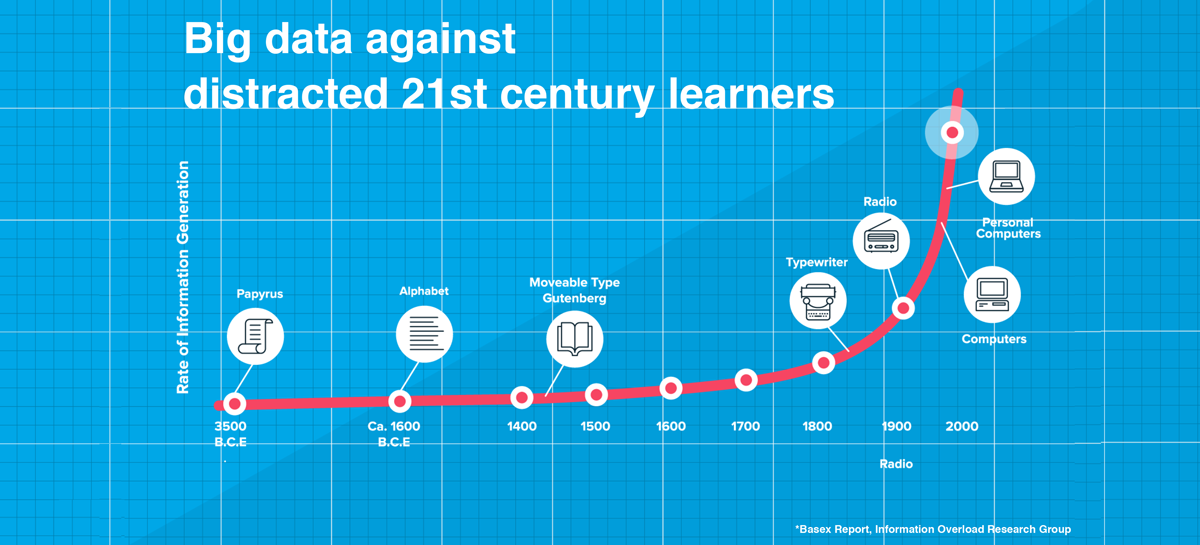
Why You Need Microlearning in 2017?
Jan 18th, 2017
Tugrul Turkkan
Micro learning, Distraction, Case Study
3 min read
Technological change demands different ways to make learning work. Why? Because the information overload (thanks to digitalization) and the distractions (thanks to digitalization) created a different learner.
Here’s a study from Basex, a New York-based research company. It shows how information generates over time. The invention of Papyrus, the Alphabet, the printing press... The rate of information generation goes relatively flat until the 20th century. But then things changed. In the second half of the 20th Century, the advances in communication and information technology led to the creation of the internet and the digital devices. This leads to a massive increase in information that is available. Now we’re facing a problem here: the information is increasing rapidly, but our cognitive capacity to digest it stays the same. We simply can’t upgrade our brains to digest more information– humans have got more or less fixed cognitive capacity. Genetically, our brains are just like our grand grandfathers.
In addition to that, a new problem emerged in the last decade... New communication mediums, emails, smart phone notifications, IM or social media leads to distractions. As I mentioned in my earlier blog post we’re distracted so easily and so much than ever before. Studies show that, what we call this «multi-tasking», is not an ideal mental state for learning. Russ Poldrack, a neuroscientist, found that learning information while multitasking causes the new information to go to the wrong part of the brain. If students study and watch TV at the same time, for example, the information from their schoolwork goes into the striatum. This region is specialized for storing new procedures and skills, but not facts and ideas. Without the distraction of TV, on the other hand, the information goes into the hippocampus, where it’s organized and categorized in a variety of ways, making it easier to retrieve. Another study from University of Utah for AAA Foundation for Traffic Safety was conducted with participants driving cars at 25 mph in a 3-mile route in Salt Lake City. The testers, while driving, make a call, send a text or tune the radio. The researchers found that, even the driver disconnects from the phone or car systems, they continue to be distracted for up to 27 seconds. Why the long distraction time? Cause we have to re-engage our mind to the task of driving.
So combine these studies... In the digital age, in the age of information overload, we have to present complex information to our professionals. This complex information leads to long learning chunks. Long learning chunks lead to lots of distractions. Because our «level of concentration» falls as time passes. There is a direct correlation between «the length of the medium» and our «attention span». Ray Jimenes, the author of «3-minute e-learning» argues that 2-4 minutes is the ideal time for e-learning in our age. For us, after producing more than 500 training videos and having feedback from our clients for the past two years, this is a viable argument.
The truth is there is no way to change this current situation. So we need to change the way we present information. And it should be based on these two facts:
- The amount of information that we’re presenting is well above the learner’s cognitive capacity to learn.
- As time passes, learners are easily distracted and they lose their concentration.
Our challenge is, how we make our professionals can get «the required information» in a limited amount of time and make our learners fully concentrated on the content. We develop a micro-learning method.
So what is a micro-learning? Micro-learning can be, you simply take the existing content, chop it up and put it online. People generally think micro-learning this way, but the truth is it should be more than that.
Micro-learning needs to have three fundamental principles...
- You need to simplify the information with the principle of «Less is More».
- Second, you need to chop it up to well planned, digestible segments.
- Third, stimulate the learner!
I’ll discuss these three principles in my next blog.
---
About the Author: Tugrul Turkkan is the founder and CEO of Vibons, a community based animation platform focused on corporate learning and communication.